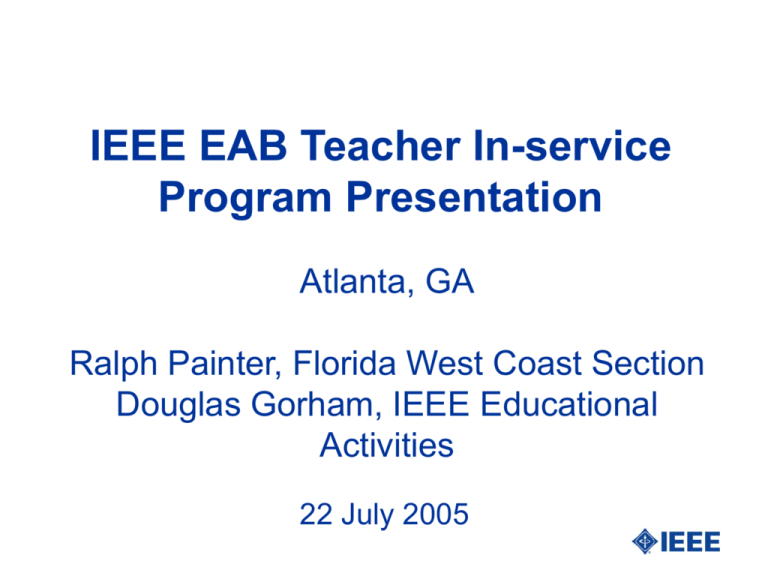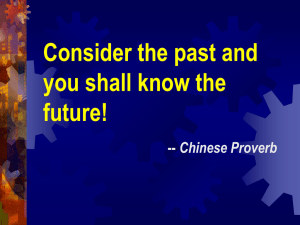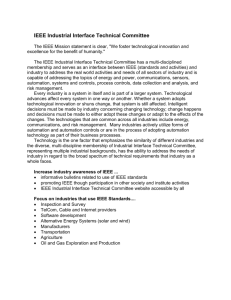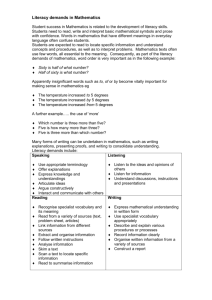Day 1 Presentation
advertisement

IEEE EAB Teacher In-service Program Presentation Atlanta, GA Ralph Painter, Florida West Coast Section Douglas Gorham, IEEE Educational Activities 22 July 2005 IEEE (The Institute of Electrical and Electronics Engineers) IEEE has over 365,000 members in more than 150 countries IEEE represents 40 engineering societies Computer, Industrial Electronics, Power, Vehicular Technology, Industry Applications IEEE is committed to enhancing mathematics, science, and technological literacy K-16 This commitment is reflected in the IEEE Constitution IEEE is a non-profit 501 (c) 3 organization Objectives To promote an awareness of the need for technological literacy To provide a hands-on demonstration of mathematics, engineering, and technology for classroom use To promote awareness of the connections between mathematics, science, and technology standards To provide information about resources available to support mathematics, science, and technology instruction What is Technological Literacy? Technological literacy is the ability to use, manage, assess and understand technology. (STL, 2000, p. 242) Change is a ubiquitous feature of contemporary life, so learning with understanding is essential to enable students to use what they learn to solve the new kinds of problems they will inevitably face in the future. (PS, 2000, p. 20-21) Students’ work with scientific investigations can be complemented by activities in which the purpose is to meet a human need, solve a human problem, or develop a product…(NSES, 1996, pg. 161) Key Ideas Technology is the modification of the natural world in order to satisfy perceived human needs and wants (ITEA, STL, p. 242). Technology is essential in teaching and learning mathematics; it influences the mathematics that is taught and enhances students’ learning (PS, p. 11). Any presentation of science without developing an understanding of technology would portray an inaccurate picture of science (National Research Council, National Science Education Standards, p. 190). “Technically Speaking” Report “As a society, we are not even fully aware of or conversant with the technologies we use every day. In short, we are not ‘technologically literate.’ “ Source: NAE. (2002). Technically Speaking: Why All Americans Need to Know More About Technology. p. 1. Washington, DC: National Academy Press. 1999 2001 Science degrees include life sciences, physical sciences, mathematics, statistics, computer sciences, engineering, manufacturing, and building 15.7 14.9 25.9 15.9 15 24.2 18.4 15.6 31.5 38.4 31 39.5 32.4 50 45 40 35 30 25 20 15 10 5 0 41.8 36 Percentage of Science Degrees Awarded South Korea Germany Czech Rep. USA Norway 2002 Source: Organization of Economic Cooperation and Development Build Your Own Robot Arm Atlanta, GA Ralph Painter, Florida West Coast Section Douglas Gorham, IEEE Educational Activities 22 July 2005 Principles & Standards for School Mathematics Geometry: Use visualization, spatial reasoning, and geometric modeling to solve problems Analyze characteristics and properties of two- and threedimensional geometric shapes and develop mathematical arguments about geometric relationships Problem Solving: Recognize and apply geometric ideas in areas outside of the mathematics classroom Apply and adapt a variety of appropriate strategies Communication: Communicate mathematical thinking coherently and clearly to peers, teachers, and others National Science Education Standards Standard E: Science and Technology Abilities to distinguish between natural objects and objects made by humans Abilities of technological design Understandings about science and technology Communicate the process of technological design Interactions of energy and matter Motion and force Standards for Technological Literacy Students will develop an understanding of… Standard 7. the influence of technology on history. Standard 8. the attributes of design. Standard 9. engineering design. Standard 10. the role of troubleshooting, research and development, invention and innovation, and experimentation in problem solving. Students will develop… Standard 11. the abilities to apply the design process. Standard 19. an understanding of and be able to select and use manufacturing technologies. Outline and Procedures Divide into teams of 3 Brainstorm and create a sketch of your design Build a model of your design with given materials Test your model Discuss and agree upon a redesign, if needed Rebuild your robot arm Retest your model Answer reflection questions as a team Reflection What was one thing you liked about your design? Are there algebraic principles that can be applied to this activity? What is one thing you would change about your design based on your experience? How might you incorporate this activity into your classroom instruction? Rotational Equilibrium: A Question of Balance Atlanta, GA Ralph Painter, Florida West Coast Section Douglas Gorham, IEEE Educational Activities 22 July 2005 Principles & Standards for School Mathematics Data Analysis and Probability: Formulate questions that can be addressed with data and collect, organize and display relevant data to answer them Develop and evaluate inferences and predictions based on data Algebra: Understand patterns, relations, and functions; Represent and analyze mathematical situations and structures using algebraic symbols; Use mathematical models to represent and understand quantitative relationships; Analyze change in various contexts. National Science Education Standards Standard A: Science as Inquiry: Abilities necessary to do scientific inquiry Understandings about scientific inquiry Standard B: Physical Science: Understanding of motions and forces Interactions of energy and matter Standard E: Science and Technology Abilities of technological design Understandings about science and technology Communicate the process of technological design Standard K-12: Unifying Concepts and Processes Evidence, models, and explanations Standards for Technological Literacy Students will develop an understanding of… Standard 8. the attributes of design. Standard 10. the role of troubleshooting, research and development, invention and innovation, and experimentation in problem solving. Students will develop… Standard 11. the abilities to apply the design process. Rotational Equilibrium- Step One Prepare the materials Rotational Equilibrium- Step Two Team predictions Rotational Equilibrium- Step Two Rotational Equilibrium- Step Two Eq. (e) 3 W X3 = W Y3, therefore Y3 = 3X3 Eq. (f) X3 + Y3 = 300mm Rotational Equilibrium- Step Two Eq. (e) is rearranged: Y3 = 3X3 Eq. (f): is rearranged: Y3 = - X3 + 300mm. Rotational Equilibrium- Step Two Generate points for: X3 0 50 Y3 = 3X3 100 Y3 Eq. (f): is rearranged: X3 Y3 0 100 Y3 = - X3 + 300mm. 200 Rotational Equilibrium- Step Two Generate points for: Y3 = 3X3 X3 0 50 100 Y3 0 150 300 Eq. (f): is rearranged: Y3 = - X3 + 300mm. X3 0 100 200 Y3 0 200 100 Rotational Equilibrium- Step Two Rotational Equilibrium- Step Three Build your mobile Rotational Equilibrium- Step Four Record your actual results Rotational Equilibrium- Step Five Analyze your results Reflection What was one thing you liked about your design? Are there algebraic principles that can be applied to this activity? Are there geometric principles used in this activity? What is one thing you would change about your design based on your experience? How might you incorporate this activity into your classroom instruction? ZOOM INTO ENGINEERING Students explore and experiment with basic engineering principles through fun, hands-on activities A focus on problem solving and inquirybased learning Grades K-5 Aligned with education standards Activity guide available www.asce.org/kids BUILDING BIG A focus on problem solving and inquiry-based learning Grades 6-8 Aligned with education standards Includes a ‘Hands On Glossary’ of engineering terms Activity guide available www.asce.org/kids IDEAS Low-Cost, “Hands-On” Engineering Projects For Middle School Math, Science And Technology www.asme.org/education/precollege/ Alternative Energy - Wind Powered Machines Amusement Park And Playground Physics Buoyant Vehicles Geodesic Domes And Sheltering Structures Historical Catapults Investigating Isaac’s Ideas Slow Roller And Friction Experiments ENGINEERS SOLVE PROBLEMS Engineers: Who They Are And What They Do The Wonderful World Of Gears Why Do Planes Fly? Amusement Park Roller Coaster How Tall Is That Flagpole Anyway? Waste Not, Want Not - How To Get Rid Of Your Garbage Ethics For Students Includes Lesson Rationale, Objectives, Lesson Plan And Enrichment Activities TEACHER IN-SERVICE PROGRAM Engineers Develop and Present Technologically Oriented Topics To PreCollege Educators Includes Practical, Applicable, HandsOn Activities Promotes Mathematics, Science and Technological Literacy 15 Lesson plans available in English and Spanish at: www.ieee.org/organizations/eab/precollege/tispt IEEE VIRTUAL MUSEUM IEEE History Center Outreach Project for Educators, Parents and Students Age 10-18 Examines History of Technology Demonstrates How Various Technologies Work Increases Understanding of the Impact of Engineering and Technology on Society DOCUMENT RESOURCES Standards for Technological Literacy: Content for the Study of Technology, 2000. ITEA Pearson, G., and A. T. Young, eds. 2002. Technically Speaking: Why All Americans Need to Know More About Technology. Committee on Technological Literacy. Washington, D.C.: National Academy Press Technological Literacy Counts: Workshop Proceedings, 1998. IEEE The Design for Science Literacy, 1999. AAAS DOCUMENT RESOURCES CONT’D ITEA. (2004, September). ITEA/Gallup Poll Reveals What People Think About Technology. Reston, Va.: ITEA National Research Council. (1996). National Science Education Standards. Washington, D.C.: National Academy Press National Council of Teachers of Mathematics. (2000). Principles and Standards for School Mathematics. Author WEBSITE RESOURCES IEEEwww.ieee.org/organizations/eab/precollege ACS- www.acs.org/edresources.htm ASCE- www.asce.org/kids Virginia Tech- www.teched.vt.edu/ctte Texas- www.texastechnology.com NASA http://aesp.nasa.okstate.edu/florida NCTM- www.nctm.org ITEA- www.iteawww.org WEBSITE RESOURCES CONT’D ASMEwww.asme.org/education/precollege/ NAE- www.nae.edu/techlit Project Lead The Way- www.pltw.org APS- www.aps.org NSTA- www.nsta.org SAE- www.awim.sae.org Eisenhower National Clearinghouse- www.enc.org www.gettech.org www.library.advanced.org/11686/ Contact Information IEEE Ralph Painter rdpainter@tecoenergy.com Douglas Gorham d.g.gorham@ieee.org ASCE Jane Howell jhowell@asce.org ASME Marina Stenos stenosm@asme.org





